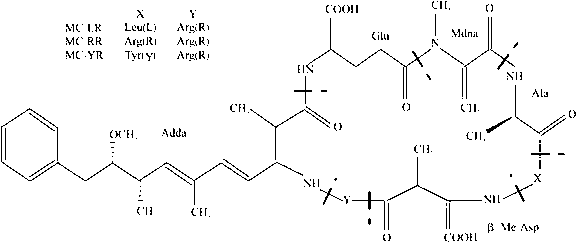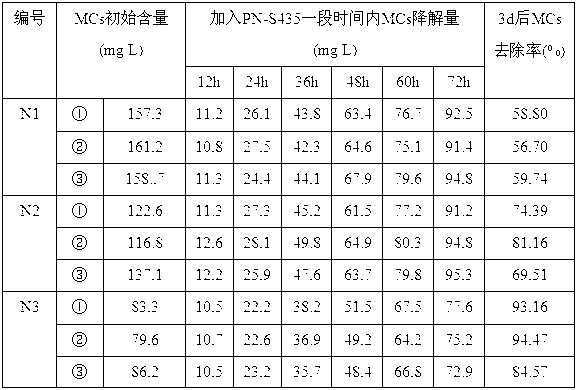Paenibacillus sp. PN-S435 and application thereof in microcystins (MCs) degradation
A technology of microcystin and bacillus, applied in the field of environmental microorganisms, can solve the problems of increased difficulty and incomplete degradation, and achieve the effect of avoiding serious threats, great social significance and economic value, and increasing the degradation rate
- Summary
- Abstract
- Description
- Claims
- Application Information
AI Technical Summary
Problems solved by technology
Method used
Image
Examples
Embodiment 1
[0051] This example illustrates the mutagenesis screening method for Paenibacillus PN-S435.
[0052] The medium used in the mutagenesis process is as follows:
[0053] Plate / slant medium: glucose 0.5%, beef extract 0.5%, tryptone 0.5%, yeast extract 0.5%, MgSO 4 0.05%, NaCl 0.2%, K 2 HPO 4 0.02%, agar 1.2%, the rest is distilled water, pH 7.4.
[0054] Lithium chloride plate medium: glucose 0.5%, beef extract 0.5%, tryptone 0.5%, yeast extract 0.5%, MgSO 4 0.05%, NaCl 0.2%, K 2 HPO 4 0.02%, agar 1.2%, lithium chloride 1.0moL·L -1 , and the rest is distilled water, pH 7.4.
[0055] MCs medium: MCs 1.8%, MgSO 4 0.05%, NaCl 0.2%, K 2 HPO 4 0.02%, agar 1.2%, the rest is distilled water, pH 7.4.
[0056] Microcystis indoor culture medium: Inoculate Microcystis aeruginosa species on BG-11 medium with an inoculation amount of 5-15% (v / v), and cultivate in a light incubator for ten days at a temperature of 28-33°C. The light intensity is 4000lx, the light-dark ratio ...
Embodiment 2
[0070] This example illustrates the identification and genetic stability of bacterial strains
[0071] The main morphology and biological characteristics of the bacterial strain Paenibacillus PN-S435 of the present invention are as follows: the cells are rod-shaped, shorter and thicker, facultative anaerobic Gram-positive bacteria, without flagella, and round spores are arranged in the cyst. On the beef extract peptone medium, the color of the colony is light yellow, the size of the colony is 1-2.5mm, the colony is round, the colony is thick, moist, the edge is neat, the surface is smooth, the texture is uniform, easy to provoke, the size of the colony is 1-2.5mm, The optimum temperature for growth: 25°C~28°C, the temperature range for growth is 15-50°C, the optimum pH for growth: 7.2~7.5, and the pH range for growth is 5.6~10.0.
[0072]This embodiment illustrates the mutant Paenibacillus obtained by screening ( Paenibacillus sp. ) Genetic stability of PN-S435. Passage deg...
Embodiment 3
[0077] This example illustrates the cultivation method of the mutant Paenibacillus PN-S435.
[0078] The medium formula described in this embodiment (% is mass percent):
[0079] Plate / slant medium: 0.5% glucose, 0.5% beef extract, 0.5% tryptone, 0.5% yeast extract, MgSO 4 0.05%, NaCl 0.2%, K 2 HPO 4 0.02%, agar 1.2%, the rest is distilled water, pH 7.4.
[0080] Fermentation medium: MCs 1.8%, MgSO 4 0.05%, NaCl 0.2%, K 2 HPO 4 0.02%, agar 1.2%, the rest is distilled water, pH 7.4.
[0081] The cultivation method comprises the steps of:
[0082] 1) Plate / slant culture: inoculate Paenibacillus PN-S435 onto a plate or slant culture medium by streaking at 25-28°C for 3-4 days;
[0083] 2) Expansion cultivation: Inoculate the Paenibacillus PN-S435 cultured on the plate in step 1) into the fermentation medium for expansion cultivation, the cultivation temperature is 25~28°C, and the cultivation time is 3~4 days;
[0084] 3) Degradation application: make the Paenibacill...
PUM
 Login to View More
Login to View More Abstract
Description
Claims
Application Information
 Login to View More
Login to View More - R&D
- Intellectual Property
- Life Sciences
- Materials
- Tech Scout
- Unparalleled Data Quality
- Higher Quality Content
- 60% Fewer Hallucinations
Browse by: Latest US Patents, China's latest patents, Technical Efficacy Thesaurus, Application Domain, Technology Topic, Popular Technical Reports.
© 2025 PatSnap. All rights reserved.Legal|Privacy policy|Modern Slavery Act Transparency Statement|Sitemap|About US| Contact US: help@patsnap.com



